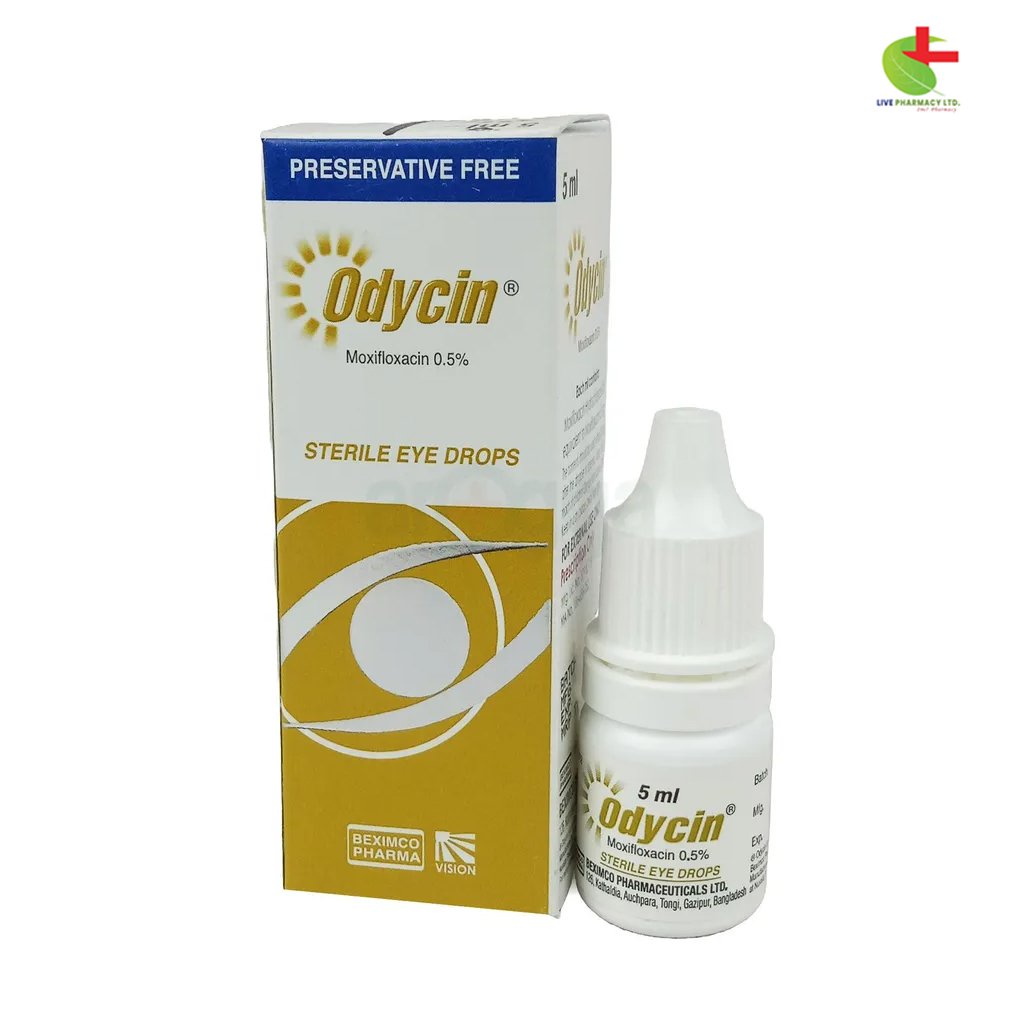Odycin Eye Drop
140.00৳ Bottle (5 ml)
- Odycin Ophthalmic Solution: Designed for treating bacterial conjunctivitis, Odycin combines Moxifloxacin to target both Gram-positive and Gram-negative bacteria, including Chlamydia trachomatis.
- It’s also used as an intraocular injection to prevent postoperative endophthalmitis.
- Effective in reducing symptoms like redness and irritation, this solution provides a comprehensive approach to managing bacterial eye infections.
 Brand
Brand
|
Beximco Pharmaceuticals Ltd |
|---|---|
 Generics
Generics
|
Moxifloxacin Hydrochloride |
Indications
Odycin ophthalmic solution is designed for the effective treatment of bacterial conjunctivitis caused by specific bacterial strains. It targets:
- Aerobic Gram-positive bacteria: Corynebacterium species, Micrococcus luteus, Staphylococcus aureus, Staphylococcus epidermidis, Staphylococcus haemolyticus, Staphylococcus hominis, Staphylococcus warneri, Streptococcus pneumoniae, Streptococcus viridans group.
- Aerobic Gram-negative bacteria: Acinetobacter lwoffii, Haemophilus influenzae, Haemophilus parainfluenzae.
- Other bacteria: Chlamydia trachomatis.
Additionally, Odycin is used as an intraocular injection to prevent postoperative bacterial endophthalmitis.
Pharmacology
Odycin contains Moxifloxacin, a potent antimicrobial agent that works by inhibiting bacterial topoisomerase II (DNA gyrase) and topoisomerase IV. These enzymes are crucial for bacterial DNA replication, transcription, and repair, as well as chromosomal DNA partitioning during cell division.
Dosage & Administration
- Eye Drops: Administer one drop into the affected eye three times daily for 7 days.
- Eye Ointment: Apply a thin layer to the affected eye three times daily for the first two days, then reduce to twice daily for the following five days, or as directed by your physician.
- Intraocular Injection: Administer 0.2-0.4 ml of Moxifloxacin prior to ocular surgery. The exact dose will be determined by your doctor.
Interactions
Odycin ophthalmic solution is unlikely to interact with other medications, as it does not inhibit key cytochrome P450 enzymes.
Contraindications
Do not use Odycin if you have a known hypersensitivity to Moxifloxacin, other quinolones, or any component of the formulation.
Side Effects
Common ocular side effects include conjunctivitis, reduced visual acuity, dry eye, keratitis, discomfort, hyperemia, pain, itching, subconjunctival hemorrhage, and tearing. Non-ocular side effects reported include fever, cough, infections, otitis media, pharyngitis, rash, and rhinitis.
Pregnancy & Lactation
Odycin should be used during pregnancy only if the benefits outweigh potential risks to the fetus. It is unknown if Moxifloxacin is excreted in human milk, so caution is advised when administering to nursing mothers.
Precautions & Warnings
Prolonged use may lead to overgrowth of non-susceptible organisms, including fungi. Discontinue use if superinfection occurs and initiate alternative treatment. Patients should avoid wearing contact lenses if they exhibit symptoms of bacterial conjunctivitis. Use magnification, such as slit lamp biomicroscopy, for examination as needed.
Therapeutic Class
Ophthalmic Antibacterial Agents
Storage Conditions
Store below 25°C, away from light, and protect from freezing. Keep out of reach of children and avoid contaminating the dropper tip. Discard one month after opening.













Reviews
There are no reviews yet.